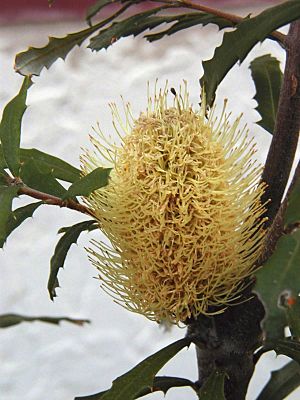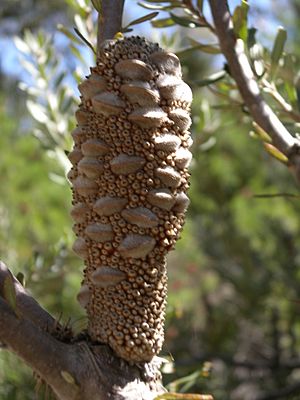Mountain banksia facts for kids
Quick facts for kids Mountain banksia |
|
|---|---|
 |
|
| Banksia canei inflorescence | |
| Scientific classification | |
| Genus: |
Banksia
|
| Species: |
canei
|
The Banksia canei, also known as the mountain banksia, is a type of shrub that grows only in southeastern Australia. It usually grows as a bushy shrub, up to 3 meters (10 feet) tall. It has narrow leaves and bright yellow flower spikes. These flower spikes appear from late summer to early winter.
After the flowers fade, up to 150 furry seed pods (called follicles) develop. These pods usually stay closed until a bushfire heats them up. Each pod holds two winged seeds. Scientists are still learning how this plant regrows after a fire, but they think it mainly grows back from these seeds. Birds like the yellow-tufted honeyeater and many insects visit the flower spikes to find food.
Gardeners find that the mountain banksia can handle frost well. However, it doesn't do as well in very dry or very humid places. It often doesn't live long in gardens. One special type, called Banksia 'Celia Rosser', was named in 1978, but it has since disappeared.
Even though there are no official subspecies, there are four main groups of this plant. These groups live in different areas and have slight differences in their leaf shapes. While it might look a bit like Banksia marginata, the mountain banksia is actually more closely related to another mountain plant, Banksia saxicola.
Contents
What Does the Mountain Banksia Look Like?
The Banksia canei is a woody shrub that can grow up to 3 meters (10 feet) tall. It often has many branches. Its bark is smooth and reddish-brown when young, turning grey as it gets older.
Leaves and Flowers
The stiff leaves grow one after another along the stems. Their shape and size can vary a lot. Adult leaves are usually narrow, about 2 to 5 centimeters (0.8 to 2 inches) long. Some populations have leaves as short as 1 cm (0.4 in) or as long as 10 cm (4 in). Young leaves are usually bigger and wider, with jagged edges. New leaves mostly grow between February and April.
The flower spikes, called inflorescences, appear from December to May, with most blooming from February to April. They grow from older branches or at the very end of a branch. These spikes are shaped like cylinders, usually 5 to 10 cm (2 to 4 in) tall and 3 to 5 cm (1.2 to 2 in) wide. Some can even reach 15 cm (6 in) tall! When they are buds, they have a purple tint, but they open into pale yellow flowers. The flowers open from the bottom of the spike to the top. The flower parts can be pale grey or blue, while the styles (a part of the flower) are yellow.
Seeds and Seedlings
As the flower spikes get older, the old flowers fall off, leaving a bare spike. Up to 150 seed pods (follicles) can grow on each spike. These pods are covered in soft, fine fur, which is light brown at first and then fades to green-grey. They are usually oval-shaped, about 12 to 18 millimeters (0.5 to 0.7 inches) long. Most of these pods stay closed until a fire, but a few might open on their own after several years.
Each pod contains two fertile seeds. Between the seeds is a woody, dark brown separator. The seeds themselves are about 13 to 18 mm (0.5 to 0.7 in) long. They have a dark brown, wing-like part and a crescent-shaped seed. The surface of the seed can be smooth or have tiny ridges, and it often looks shiny. When a seed sprouts, it first grows two oval-shaped leaves called cotyledons. These can stay for several months as more leaves appear.
How Scientists Classify the Mountain Banksia
The Banksia canei was first officially described in 1967 by a scientist named James Hamlyn Willis. He found it in Victoria, Australia. Other scientists had collected it earlier, but they thought it was just a different type of the common Banksia marginata. Willis named the plant after Bill Cane, who had noticed this unusual banksia.
Scientists classify plants to understand how they are related. The mountain banksia is part of the Banksia genus. It's placed in a group with other banksias that have straight styles (a part of the flower) and cylindrical flower spikes. Even though it looks like B. marginata, it's more closely related to B. integrifolia and Banksia saxicola.
Scientists have also studied the DNA of banksias to understand their family tree. These studies suggest that Banksia canei is an early branch within its group.
Where the Mountain Banksia Lives
The mountain banksia grows in several separate areas in the alpine regions of southeastern Australia. It's usually found at altitudes between 500 to 1000 meters (1,600 to 3,300 feet) in northeastern Victoria and southeastern New South Wales. One group was even found at a lower height of 250 m (820 ft) in an area partly cleared for farming.
This species is considered "Rare in Victoria" by the state's Department of Sustainability and Environment. A scientist named Alf Salkin described four main groups of these plants. He called them topodemes, which means "people of a place." These groups are found in rocky, granite-based soils in mountain areas. They are separated by wide river valleys.
Each of these four main groups has slightly different leaf shapes. Salkin believed these differences happened by chance over time, as the groups became separated.
Most populations are found south or east of the Great Dividing Range. The main groups are:
- Wellington River form: Found in the Snowy Range. Its adult leaves have very noticeable jagged edges. The flowers have a blue-grey color.
- Snowy Mountains form: Found north of the Snowy Mountains. This group has the smallest seed pod spikes. Its adult leaves are longer, and its flowers are small. Like the Wellington River form, its flowers are blue-grey.
- Wulgulmerang form: Located north and east of Omeo. Its flowers are more yellow-brown, and its seed pod spikes look like those of B. marginata. It often grows among granite rocks with the candlebark tree.
- Kybean Range form: Found in southeastern New South Wales. This group has the largest flower spikes and seed pod spikes. Its adult leaves are very short, but its young leaves are wide, similar to Banksia integrifolia.
There has been one report of this plant growing naturally in Western Australia, on a roadside.
Life Cycle and Ecology
Banksia flower spikes are a vital food source for many animals, including mammals, insects, and birds. They provide a sugary liquid called nectar. Animals seen feeding on B. canei flower spikes include the yellow-tufted honeyeater, bees, wasps, and ants.
The mountain banksia does not have a lignotuber (a woody swelling at the base that helps some plants regrow after fire). It seems to regrow from seeds after a bushfire. Its seed pods usually stay closed until a fire, though some might open on their own after about five years. A fungus can infect older cones and seeds, making seeds older than five years often unable to grow.
Growing Mountain Banksia in Gardens
The Banksia canei grows slowly in gardens. It can take about five to seven years for a plant grown from seed to flower. Its furry seed pods are pretty, but they are often hidden by the leaves.
Even though it has been grown successfully in England and can handle temperatures down to -12°C (10°F), the mountain banksia can be hard to keep alive in Australian gardens. Young plants often do well in pots but die once planted in the ground. It can handle frost but struggles with very dry or very humid conditions. This plant prefers a sunny spot and soil that drains well. It has been grown in inland New South Wales.
To get Banksia canei seeds to sprout, they need a special treatment called stratification. This means storing them at 5°C (41°F) for 60 days. After this, they usually sprout in another 6 to 25 days. Scientists think this is important so that seeds released by a summer or autumn bushfire will stay dormant through winter and sprout in spring.
In 1975, a scientist named Alf Salkin grew about a thousand mountain banksia seedlings. Two seedlings from one group grew with deeply cut leaves and a sprawling shape. One of these survived and was named a special type called Banksia 'Celia Rosser' in 1978. It was named after Celia Rosser, an artist who drew many banksias. This special plant produced many small flower spikes. Salkin thought it was important because it showed an older, possibly ancestral, form of the plant reappearing. However, this special type has since disappeared.


